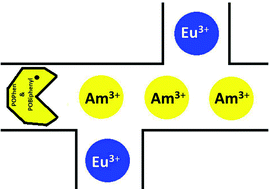Preorganization of N,O-hybrid phosphine oxide chelators for effective extraction of trivalent Am/Eu ions – a computational study†
Abstract
N,O-Hybrid phosphine oxide ligands with N-heterocyclic cores are advanced extractants for extracting actinides over lanthanides. However, the challenging task in designing an efficient hybrid ligand is tracing the origin of the extraction and its ability to form complexes. In this work, four ligands with different cores (phenanthroline and biphenyl) along with phenyl and pyrrole substitution are optimized using density functional theory (DFT) calculations to understand the complexation and extraction of Am(III) over Eu(III) in a water medium. Results demonstrate that the biphenyl core with phenyl-substituted ligands is better for the complexation process whereas the phenanthroline core with pyrrole-substituted ligands is better for the partitioning of Am(III) ions over Eu(III) ions. Natural orbitals for chemical valence (NOCV) and energy decomposition analysis (EDA) show that Am complexes are mainly formed due to the orbital interactions in both 1 : 1 and 1 : 2 complexes. Quantum theory of atoms in molecules (QTAIM) analysis provides insight into the strength of the coordinate bonds formed between the ligands and the metal ions. Finally, this work showed that preorganized ligands can enhance the complexation ability and the extraction of Am(III) ions over Eu(III) ions. This work will help others in redefining the parameters required to design ligands for lanthanide/actinide separation in nuclear-waste management.



 Please wait while we load your content...
Please wait while we load your content...